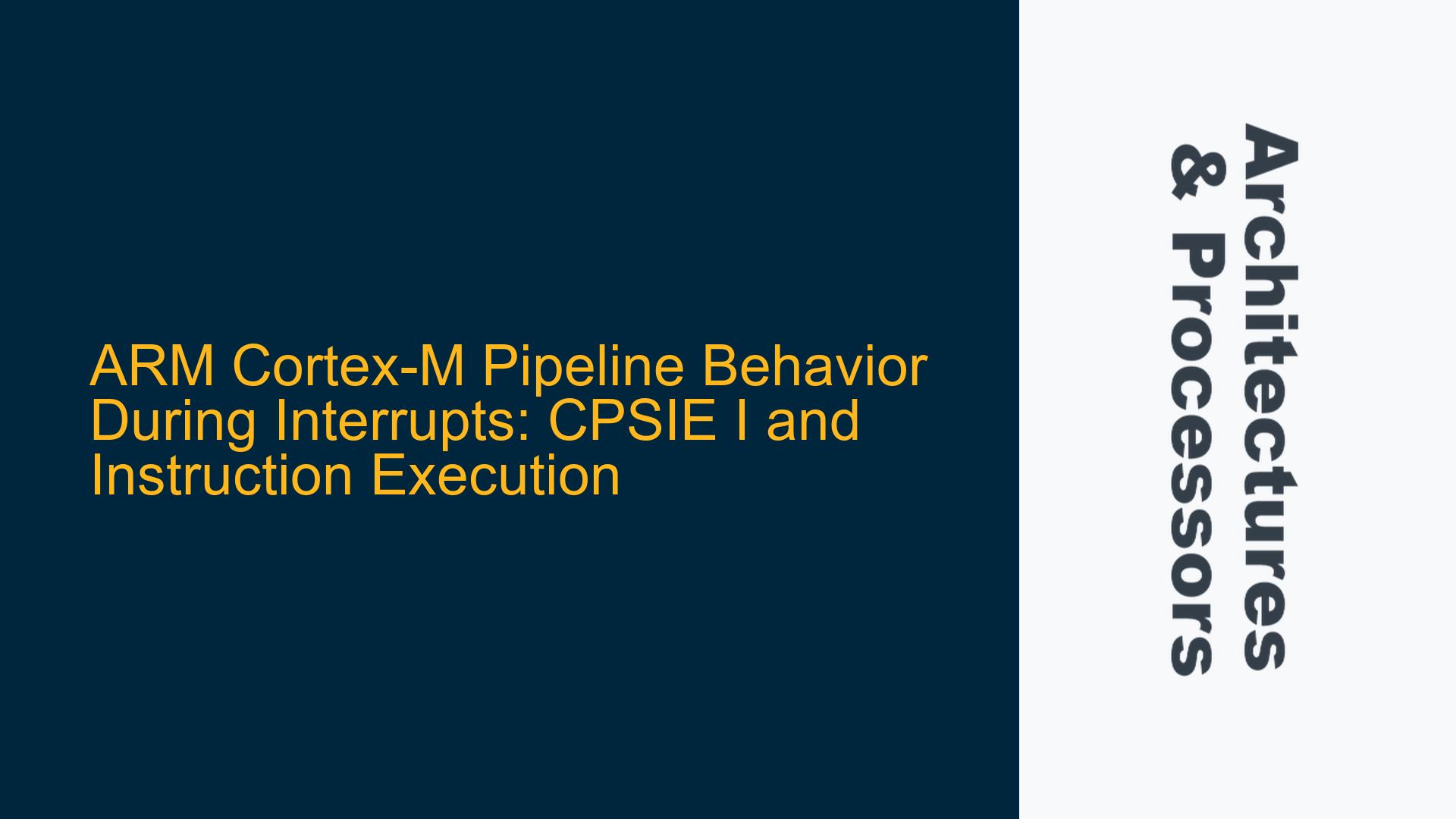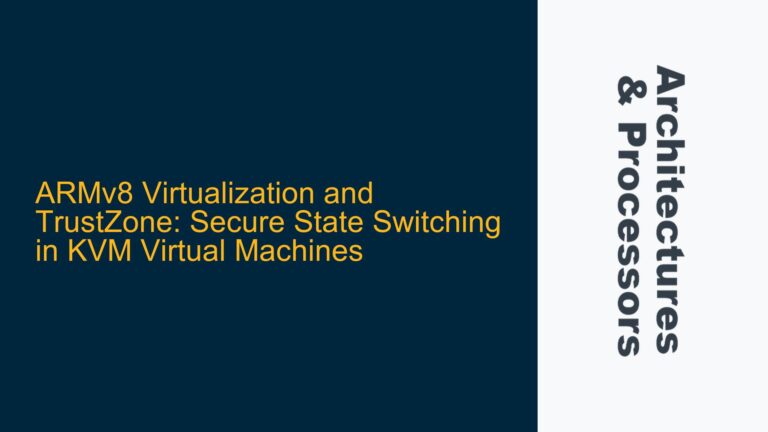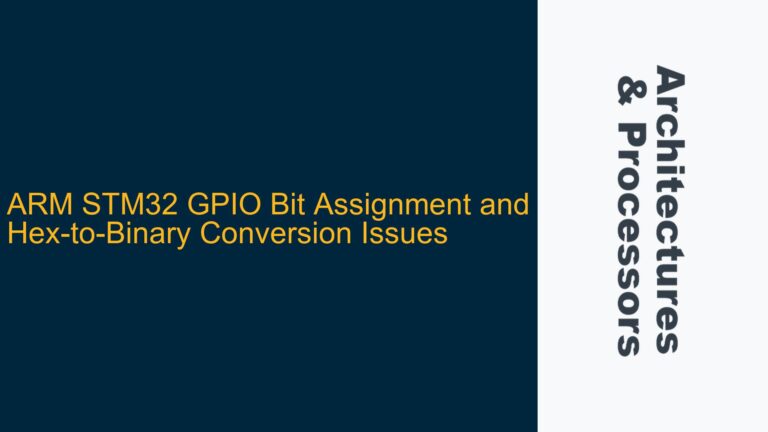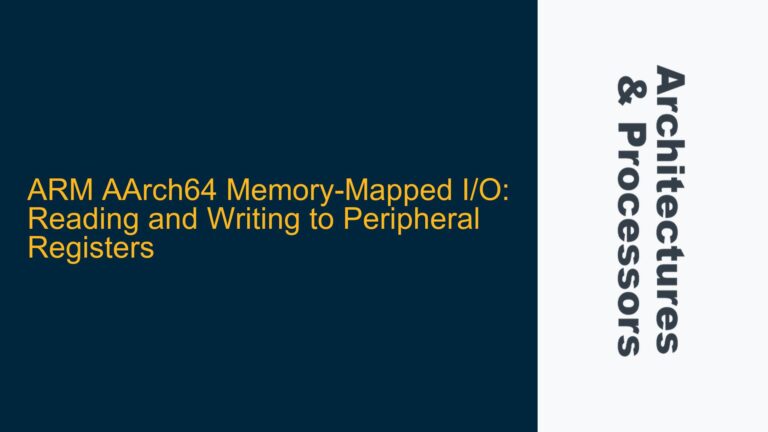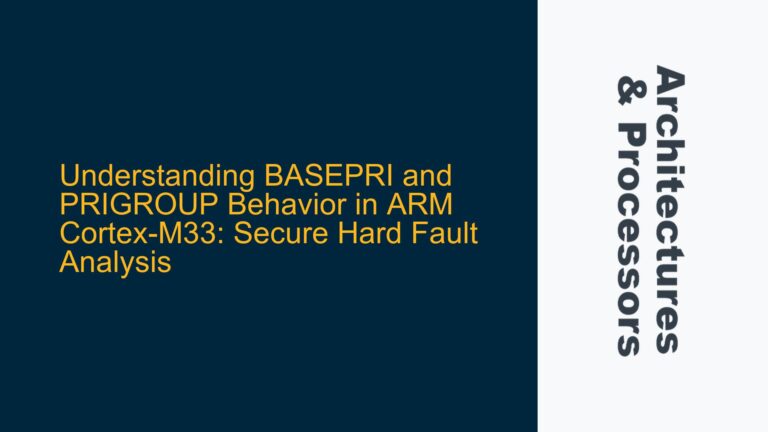ARM Cortex-M Pipeline Behavior During Interrupts: CPSIE I and Instruction Execution
The ARM Cortex-M series of processors, particularly the Cortex-M0 and Cortex-M0+, are widely used in embedded systems due to their efficiency and low power consumption. One of the critical aspects of these processors is their handling of interrupts, especially when interrupts are enabled using the CPSIE I instruction. Understanding the behavior of the pipeline during such events is crucial for writing reliable and efficient firmware. This post delves into the intricacies of how the ARM Cortex-M pipeline behaves when an interrupt occurs immediately after enabling interrupts, and how this behavior can impact your code.
Pipeline Flush and Interrupt Handling After CPSIE I
When an interrupt occurs on an ARM Cortex-M processor, the processor must handle the interrupt in a way that ensures the integrity of the program state. The CPSIE I instruction is used to enable interrupts, and if an interrupt is pending at the time this instruction is executed, the processor will immediately begin handling the interrupt. However, the exact behavior of the pipeline during this transition is nuanced and depends on the specific Cortex-M core being used.
In the case of the Cortex-M0 and Cortex-M0+, the pipeline is flushed when an interrupt is accepted. This means that any instructions that were in the pipeline at the time the interrupt was accepted are discarded, and the processor begins executing the interrupt service routine (ISR) immediately. However, the ARM documentation suggests that under certain conditions, the processor may execute up to one additional instruction before entering the ISR. This behavior is critical to understand because it can affect the timing and predictability of your code.
The pipeline flush occurs because the processor must ensure that the state of the system is consistent before entering the ISR. If the pipeline were not flushed, there could be a risk of partially executed instructions affecting the state of the system, leading to unpredictable behavior. The flush ensures that all instructions up to the point of the interrupt are fully executed, and any instructions that were in the pipeline but not yet executed are discarded.
The execution of up to one additional instruction before entering the ISR is a result of the pipeline’s structure and the timing of the interrupt acceptance. The Cortex-M0 and Cortex-M0+ processors have a three-stage pipeline (fetch, decode, execute), and the timing of the interrupt acceptance relative to the pipeline stages can result in one additional instruction being executed before the ISR begins. This behavior is documented in the ARM Cortex-M programming guides, but it is often overlooked by developers who are not familiar with the low-level details of the processor’s operation.
Memory Barriers and Instruction Execution Timing
The behavior of the pipeline during interrupt handling is closely related to the concept of memory barriers. Memory barriers are used to ensure that memory operations are completed in a specific order, which is critical in multi-threaded or interrupt-driven systems. In the context of the ARM Cortex-M processors, memory barriers are particularly important when dealing with interrupts and the CPSIE I instruction.
The ARM documentation specifies that if an interrupt is already pending when the CPSIE I instruction is executed, the processor will accept the interrupt after the CPSIE I instruction is completed. However, the processor may execute up to one additional instruction before entering the ISR. This behavior is influenced by the timing of the interrupt acceptance relative to the pipeline stages, as mentioned earlier.
To ensure that the interrupt is recognized immediately after the CPSIE I instruction, the ARM documentation recommends using memory barrier instructions. Specifically, the ISB (Instruction Synchronization Barrier) instruction can be used to ensure that the pipeline is flushed and that the interrupt is recognized immediately. The ISB instruction forces the processor to complete all previous instructions before proceeding, which ensures that the interrupt is handled as soon as possible.
The use of memory barriers is particularly important in real-time systems where the timing of interrupt handling is critical. For example, in an RTOS (Real-Time Operating System), the timing of context switches and interrupt handling can have a significant impact on the system’s performance and reliability. By using memory barriers, developers can ensure that interrupts are handled in a predictable and timely manner, which is essential for maintaining the real-time behavior of the system.
Practical Implications and Best Practices
The behavior of the ARM Cortex-M pipeline during interrupt handling has several practical implications for firmware developers. Understanding this behavior is essential for writing code that is both efficient and reliable, particularly in real-time systems where the timing of interrupt handling is critical.
One of the key implications of the pipeline behavior is that developers must be aware of the potential for additional instructions to be executed after the CPSIE I instruction before the ISR begins. This behavior can affect the timing of critical sections of code, particularly if the code relies on the immediate recognition of interrupts. In such cases, the use of memory barriers, such as the ISB instruction, is essential to ensure that the interrupt is recognized immediately.
Another implication is that developers must be careful when writing code that relies on the precise timing of interrupt handling. For example, if a critical section of code is protected by disabling interrupts, the developer must ensure that the critical section is as short as possible to minimize the risk of missing an interrupt. Additionally, the use of memory barriers can help to ensure that interrupts are recognized as soon as possible after they are enabled, which can help to reduce the latency of interrupt handling.
In summary, the behavior of the ARM Cortex-M pipeline during interrupt handling is a complex but critical aspect of writing efficient and reliable firmware. By understanding the pipeline behavior and using memory barriers appropriately, developers can ensure that their code is both efficient and reliable, particularly in real-time systems where the timing of interrupt handling is critical.
Implementing Data Synchronization Barriers and Cache Management
To address the issues related to pipeline behavior and interrupt handling, developers can implement data synchronization barriers and cache management techniques. These techniques are particularly important in systems where the timing of interrupt handling is critical, such as in real-time operating systems or high-performance embedded systems.
The ISB instruction is a key tool for ensuring that the pipeline is flushed and that interrupts are recognized immediately after the CPSIE I instruction. By inserting an ISB instruction after the CPSIE I instruction, developers can ensure that the pipeline is flushed and that the interrupt is recognized as soon as possible. This is particularly important in systems where the timing of interrupt handling is critical, such as in real-time systems or systems with tight timing constraints.
In addition to the ISB instruction, developers can also use the DSB (Data Synchronization Barrier) instruction to ensure that all memory operations are completed before proceeding. The DSB instruction is particularly useful in systems where multiple processors or DMA (Direct Memory Access) engines are accessing shared memory. By using the DSB instruction, developers can ensure that all memory operations are completed before proceeding, which can help to prevent race conditions and ensure the integrity of the system.
Cache management is another important aspect of ensuring reliable interrupt handling. In systems with caches, it is important to ensure that the cache is properly managed to prevent stale data from being used. The ARM Cortex-M processors provide several cache management instructions, such as the DMB (Data Memory Barrier) and DCISW (Data Cache Invalidate by Set/Way) instructions, which can be used to ensure that the cache is properly managed.
In summary, implementing data synchronization barriers and cache management techniques is essential for ensuring reliable interrupt handling in ARM Cortex-M systems. By using the ISB and DSB instructions, developers can ensure that the pipeline is flushed and that memory operations are completed before proceeding. Additionally, by using cache management instructions, developers can ensure that the cache is properly managed, which can help to prevent stale data from being used and ensure the integrity of the system.
Conclusion
The behavior of the ARM Cortex-M pipeline during interrupt handling is a complex but critical aspect of writing efficient and reliable firmware. By understanding the pipeline behavior and using memory barriers appropriately, developers can ensure that their code is both efficient and reliable, particularly in real-time systems where the timing of interrupt handling is critical. The use of data synchronization barriers and cache management techniques is essential for ensuring reliable interrupt handling, and developers should be familiar with these techniques to ensure the integrity and performance of their systems.
In conclusion, the ARM Cortex-M pipeline behavior during interrupt handling is a nuanced topic that requires a deep understanding of the processor’s architecture and the use of appropriate synchronization techniques. By following the best practices outlined in this post, developers can ensure that their code is both efficient and reliable, even in the most demanding real-time systems.
